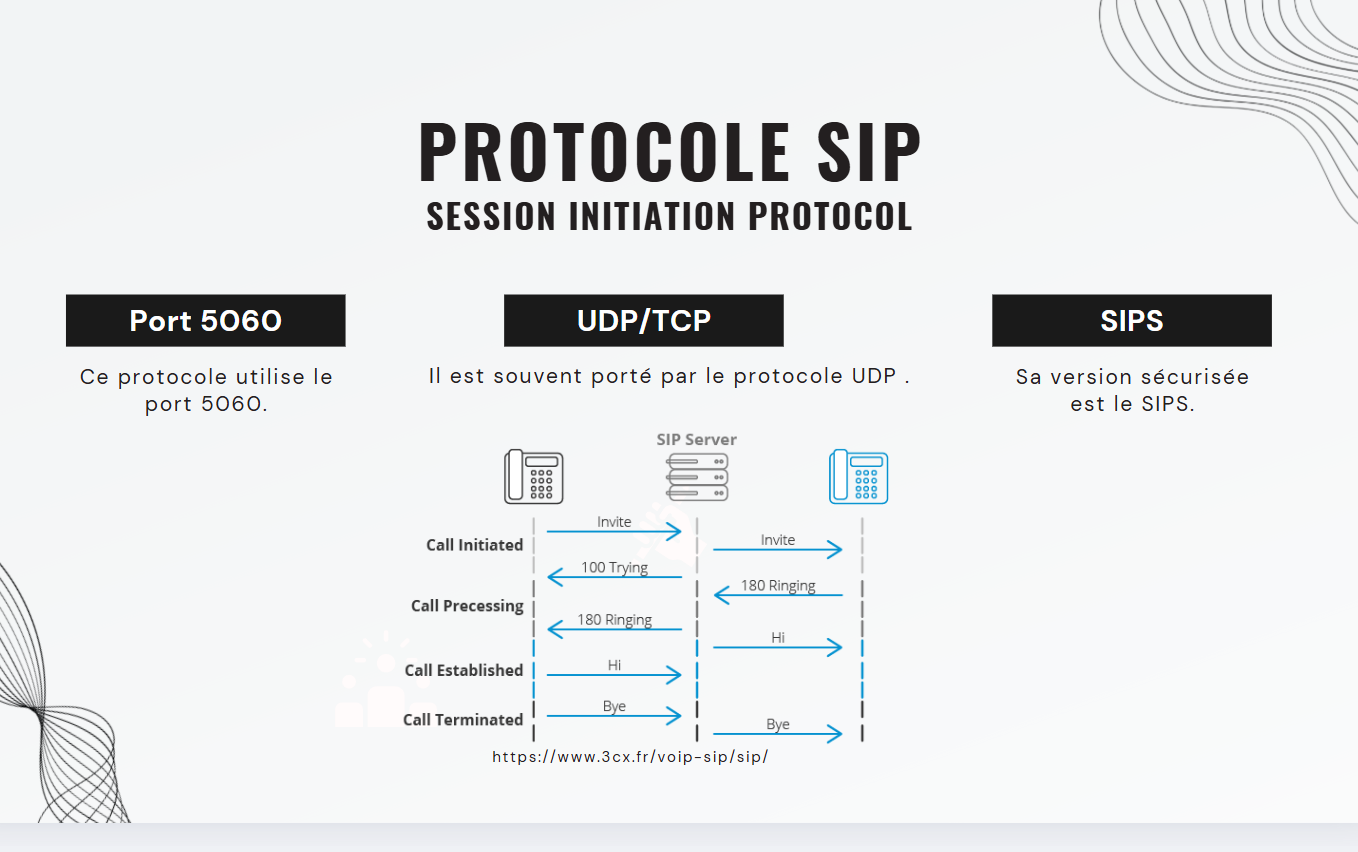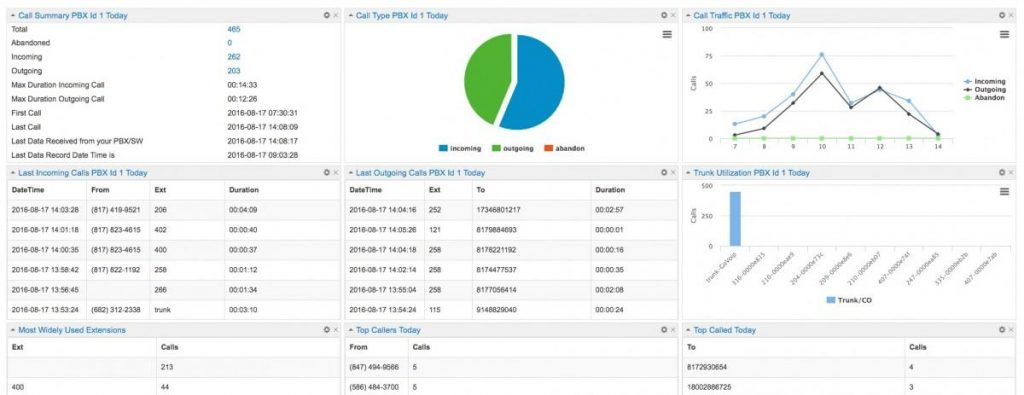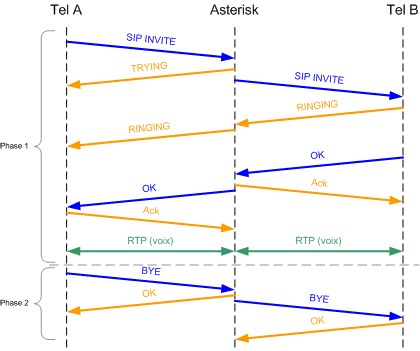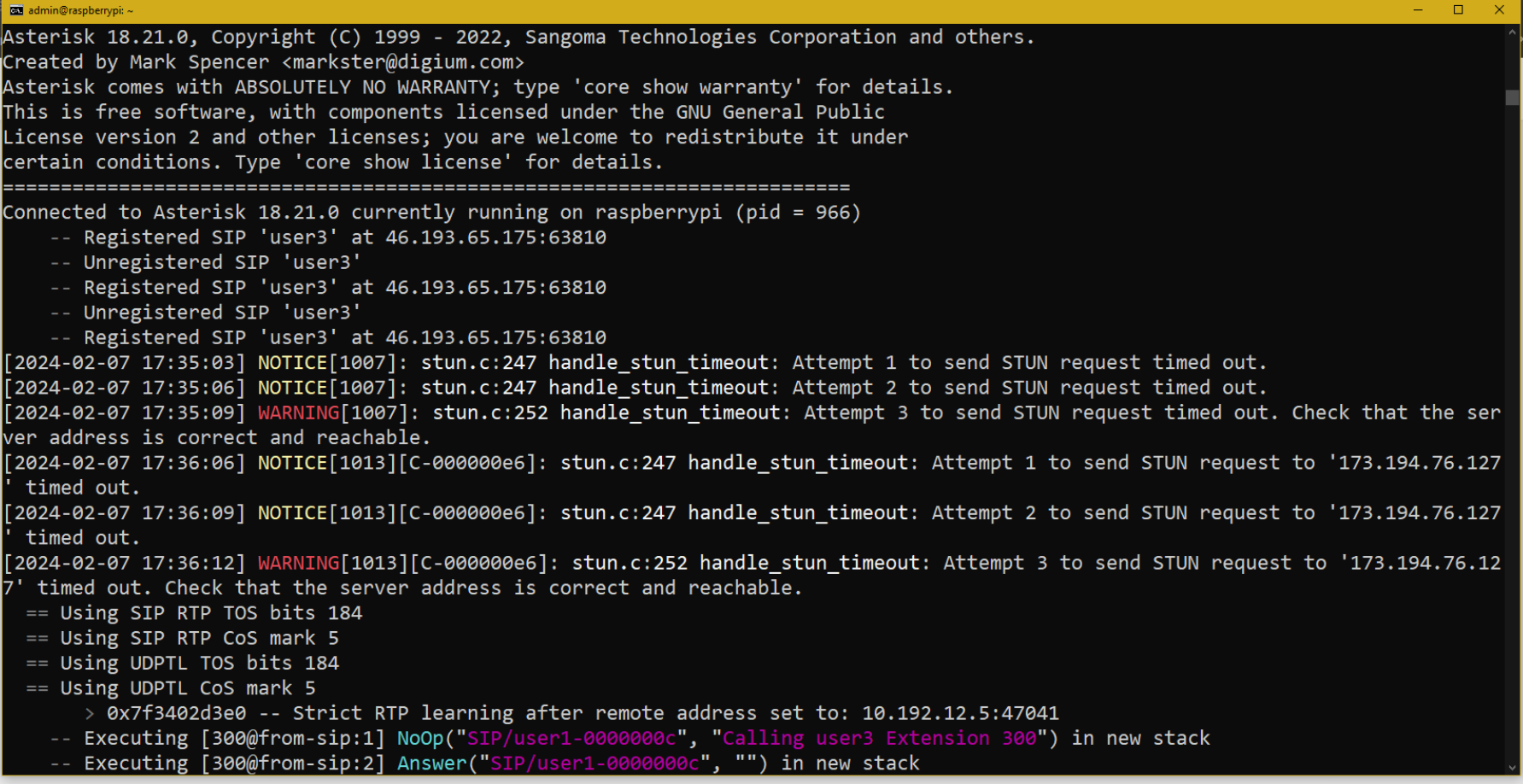Présentation du Projet Project Overview

Ce projet innovant consistait à déployer un serveur VoIP Asterisk sur Raspberry Pi avec des intégrations avancées vers des services web modernes. Le système gère non seulement les communications téléphoniques traditionnelles, mais aussi l'intégration avec Discord, les WebSockets en temps réel, et une interface web personnalisée pour la surveillance et l'administration.
Le serveur a été configuré avec des règles de sécurité strictes, incluant la gestion NAT/firewall, la limitation d'accès par IP, et l'authentification renforcée. Des scripts Python personnalisés ont été développés pour automatiser les tâches et rediriger les appels vers des services web externes.
L'architecture permet la surveillance en temps réel des appels via WebSocket, l'envoi de notifications Discord automatiques, et la gestion d'extensions dynamiques avec redirection vers des serveurs web.
This innovative project involved deploying an Asterisk VoIP server on Raspberry Pi with advanced integrations to modern web services. The system handles not only traditional telephone communications but also integration with Discord, real-time WebSockets, and a custom web interface for monitoring and administration.
The server was configured with strict security rules, including NAT/firewall management, IP access limitation, and enhanced authentication. Custom Python scripts were developed to automate tasks and redirect calls to external web services.
The architecture enables real-time call monitoring via WebSocket, automatic Discord notifications, and dynamic extension management with redirection to web servers.
Détails Techniques Technical Details
Technologies Utilisées Technologies Used
Durée du Projet Project Duration
4 mois (Septembre - Décembre 2024) 4 months (September - Decembre 2024)
Défis et Solutions Challenges and Solutions
Les principaux défis techniques rencontrés lors de ce projet étaient:
- Configuration avancée NAT/firewall pour permettre les communications SIP à travers différents réseaux
- Développement d'un système de hooks Discord pour les notifications d'appels en temps réel
- Intégration WebSocket pour le streaming des logs vers l'interface web
- Création de scripts Python pour la redirection dynamique d'extensions vers des serveurs web
- Gestion des permissions et sécurisation contre les attaques SIP (déni d'IP, authentification)
- Optimisation des performances sur Raspberry Pi avec gestion des codecs audio
The main technical challenges encountered during this project were:
- Advanced NAT/firewall configuration to enable SIP communications across different networks
- Development of a Discord webhook system for real-time call notifications
- WebSocket integration for log streaming to the web interface
- Creation of Python scripts for dynamic extension redirection to web servers
- Permission management and security against SIP attacks (IP denial, authentication)
- Performance optimization on Raspberry Pi with audio codec management
Exemples de Code Code Examples
Advanced SIP Configuration with Security
[general]
nat=force_report,comedia
udpbindaddr=0.0.0.0:5060
transport=udp
rtp_symmetric=yes
context=from-outside
realm=raspberrypi.local
alwaysauthreject=yes
videosupport=yes
localnet=192.168.1.22/255.255.255.0
externip=31.35.187.131
canreinvite=no
disallow=all
allow=ulaw
allow=g729
directmedia=no
rtptimeout=120
rtpkeepalive=60
contactdeny=142.93.102.164/255.255.255.255
permit=46.139.65.175/255.255.255.255
permit=192.168.0.0/255.255.0.0Configuration SIP avancée avec sécurité renforcée, gestion NAT et limitations d'accès par IP. Advanced SIP configuration with enhanced security, NAT management and IP access limitations.
Discord Webhook Integration Script
#!/usr/bin/env python3
import requests
import json
import sys
from datetime import datetime
def send_discord_notification(caller_id, extension, status):
webhook_url = "https://discord.com/api/webhooks/YOUR_WEBHOOK_URL"
timestamp = datetime.now().strftime("%Y-%m-%d %H:%M:%S")
embed = {
"title": "📞 Asterisk Call Notification",
"description": f"Call {status}",
"color": 0x00ff00 if status == "connected" else 0xff0000,
"fields": [
{"name": "Caller ID", "value": caller_id, "inline": True},
{"name": "Extension", "value": extension, "inline": True},
{"name": "Time", "value": timestamp, "inline": True}
],
"footer": {"text": "Asterisk VoIP Server"}
}
payload = {"embeds": [embed]}
try:
response = requests.post(webhook_url, json=payload)
if response.status_code == 204:
print(f"Discord notification sent successfully")
else:
print(f"Failed to send notification: {response.status_code}")
except Exception as e:
print(f"Error sending Discord notification: {e}")
if __name__ == "__main__":
if len(sys.argv) >= 4:
send_discord_notification(sys.argv[1], sys.argv[2], sys.argv[3])Script Python pour envoyer des notifications Discord en temps réel lors des appels. Python script to send real-time Discord notifications during calls.
WebSocket Log Streaming
#!/usr/bin/env python3
import websocket
import json
import subprocess
import threading
import time
class AsteriskLogStreamer:
def __init__(self, websocket_url):
self.ws_url = websocket_url
self.ws = None
def connect_websocket(self):
try:
self.ws = websocket.WebSocketApp(self.ws_url,
on_open=self.on_open,
on_message=self.on_message,
on_error=self.on_error,
on_close=self.on_close)
self.ws.run_forever()
except Exception as e:
print(f"WebSocket error: {e}")
def on_open(self, ws):
print("WebSocket connection established")
def stream_asterisk_logs(self):
try:
process = subprocess.Popen(
['tail', '-f', '/var/log/asterisk/full'],
stdout=subprocess.PIPE,
stderr=subprocess.PIPE,
universal_newlines=True
)
for line in iter(process.stdout.readline, ''):
if self.ws:
log_data = {
"timestamp": time.time(),
"message": line.strip(),
"source": "asterisk"
}
self.ws.send(json.dumps(log_data))
except Exception as e:
print(f"Error streaming logs: {e}")
def start_streaming(self):
ws_thread = threading.Thread(target=self.connect_websocket)
log_thread = threading.Thread(target=self.stream_asterisk_logs)
ws_thread.start()
time.sleep(2) # Wait for WebSocket connection
log_thread.start()Système de streaming des logs Asterisk vers une interface web via WebSocket. Asterisk log streaming system to web interface via WebSocket.
Dynamic Extension Redirection
#!/usr/bin/env python3
import requests
import sys
import json
import time
def redirect_to_web_server(extension, destination_url):
"""Redirect extension call to web server endpoint"""
payload = {
"extension": extension,
"timestamp": time.time(),
"action": "call_redirect",
"caller_info": {
"extension": extension,
"server": "raspberrypi.local"
}
}
try:
response = requests.post(
f"{destination_url}/api/asterisk/call",
json=payload,
headers={"Content-Type": "application/json"},
timeout=10
)
if response.status_code == 200:
result = response.json()
print(f"SUCCESS: {result.get('message', 'Call redirected')}")
return True
else:
print(f"ERROR: Server returned {response.status_code}")
return False
except requests.exceptions.RequestException as e:
print(f"ERROR: Failed to contact web server: {e}")
return False
if __name__ == "__main__":
if len(sys.argv) >= 3:
extension = sys.argv[1]
web_server_url = sys.argv[2]
redirect_to_web_server(extension, web_server_url)Script de redirection dynamique d'extensions vers des serveurs web externes. Dynamic extension redirection script to external web servers.
Galerie du Projet Project Gallery



Conclusion et Résultats Conclusion and Results
Le serveur VoIP Asterisk a été déployé avec succès sur Raspberry Pi, offrant une solution complète et moderne de télécommunications. Le système a permis de réduire les coûts tout en ajoutant des fonctionnalités innovantes comme les notifications Discord automatiques et la surveillance en temps réel.
L'intégration WebSocket permet aux administrateurs de surveiller les appels en direct depuis l'interface web, tandis que les scripts Python automatisent les tâches complexes de routage et de redirection. Cette architecture hybride IoT/VoIP démontre la capacité d'intégrer des technologies traditionnelles avec des services web modernes.
The Asterisk VoIP server was successfully deployed on Raspberry Pi, providing a complete and modern telecommunications solution. The system reduced costs while adding innovative features like automatic Discord notifications and real-time monitoring.
The WebSocket integration allows administrators to monitor calls live from the web interface, while Python scripts automate complex routing and redirection tasks. This hybrid IoT/VoIP architecture demonstrates the ability to integrate traditional technologies with modern web services.